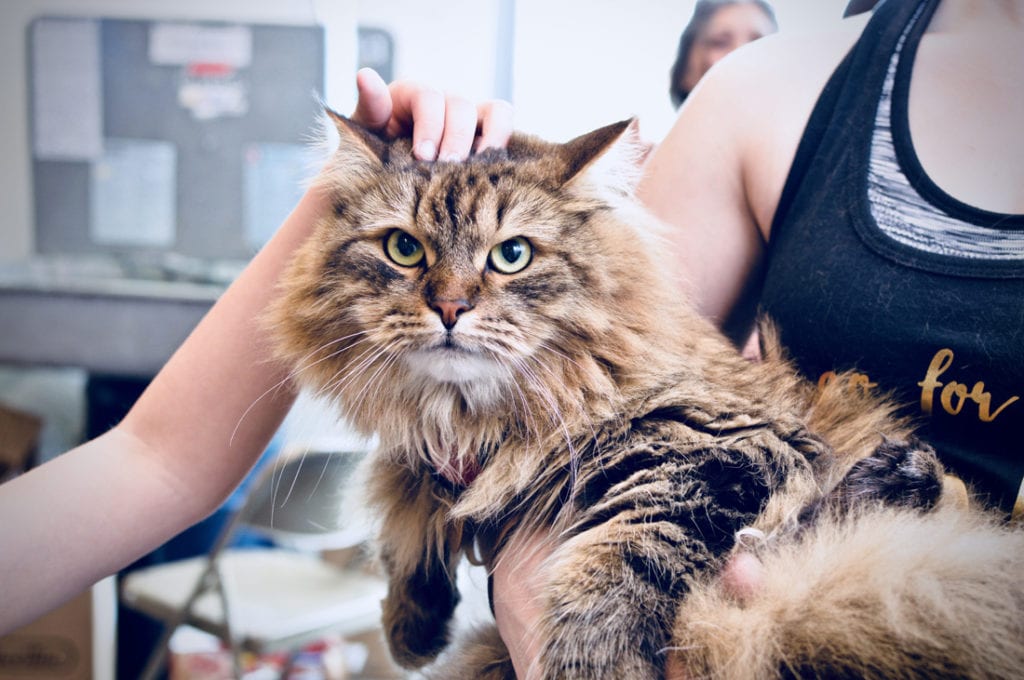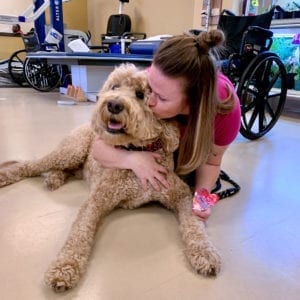A furry face and a snuggle might be just what the doctor ordered

When Indy, a spirited goldendoodle, enters A.G. Rhodes Long Term Care and Rehabilitation at Emory, residents’ faces light up.
“Many patients suffer from memory loss, but 99% of the time just seeing Indy’s big fluffy head walk through the door brings a smile, starts a conversation and triggers a memory of a beloved pet from long ago,” says Indy’s owner, Lee Ann Kaplan.
Indy is a Therapy Pets Unlimited certified therapy dog who frequents the senior care facility, visiting patients in their rooms and assisting in physical therapy. Kaplan has countless heartwarming stories of Indy engaging with residents and delighting patients who are eager to pet her dog’s curly head and floppy ears.

“One of my favorites was when a particularly stubborn patient didn’t want to do her walking therapy until she was allowed to ‘walk’ Indy down the hall—with assistance and a walker,” she says. “Then she was all in.”
Therapy animals like Indy are trained to provide affection and support to people in a variety of places, such as hospitals and retirement homes. And while you may be more likely to encounter a therapy dog, canines aren’t the only animals bringing a bit of feel-good therapy.
In fact, McKinley, a Siberian cat based in Sandy Springs, proves that felines can be just as skilled at providing comfort.
McKinley is an emotional support animal for his owner, Charlotte Simons, and he accompanied her to college in rural Washington, where he won hearts everywhere he went. “He was so personable and loved attention,” says Simons. “I watched other stressed-out students light up when they got to pet him. That gave me the idea that he could help other people too just as much as he has helped me.”
Because there was no established agency nearby, Simons began working independently with McKinley, who is leash trained. She exposed him to sights and sounds he may encounter while volunteering, including loud noises, wheelchairs, elevators, crutches and children. She also taught him to be non-reactive to being touched, especially in sensitive areas like his stomach, feet and tail.
This was sufficient for the volunteer work she and her cat did in college. Now that she’s back in the Atlanta area, Simons is working with Pet Partners so McKinley can get certified and begin volunteering locally.
“I always enjoy [going to] nursing homes because the residents are used to seeing dogs,” says Simons. “Many people miss their cats and never expected to see one in person again.”
Kaplan agrees that exposure and training is an important part of preparing any animal for therapy work. “They need to be bomb proof, focused and unfazed by any crazy thing that may happen,” she says. “On our very first visit, we were crammed into the back of a freight elevator with three wheelchair patients, plus staff. A fire alarm went off right near Indy’s head while he was visiting with a group of patients, and a wheelchair ran over his tail. Luckily, he was unfazed by it all.”
DETAILS
Therapy Pets Unlimited
therapypetsunlimited.org
Pet Partners
petpartners.org
Follow these therapy pets on Instagram: @indythegoldendoodle and @mckinleythecat.
Writer and pet columnist at Simply Buckhead. Author, AdventureCats.org founder, total cat lady.












